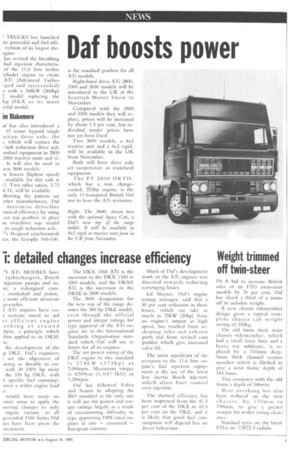1: detailed changes increase efficiency Weight trimmed
Page 7

If you've noticed an error in this article please click here to report it so we can fix it.
''S ATi MODELS have turbochargers, Bosch injection pumps and inrs, a redesigned cam:, crankshaft and piston, a more efficient air-to-air ge-cooler.
1 ATi engines have ex
Systems tuned to aid re efficient engine athing at around -)rpm, a principle which first applied to its DKSE 71C.
the development of the p DKZ, Dal's engineers 7 set the objectives of ucing as durable an enwith 30 DIN hp more the 330 hp DKX, with '1' specific fuel consumpover a wider engine load would have made no mine sense to apply the leering changes to Only engine variant, so all ge-cooled 1160 Series Daf ties have been given the treatment. The DKX 1160 ATi is the successor to the DKX 1160 in 3300 models, and the DK XE ATi is the successor to the DKSE in 2800 models.
The 3600 designation for the new top of the range denotes the 360 bp DKZ model, even though the official power and torque ratings for type approval of the ATi engines are to the International Standards Organisation standard which Daf will use in future for all its engines.
The net power rating of the DKI, engine to this standard is 274kW (373hp) at 2,000rpm. Maximum torque is 420Nin (1,047 lbft) at 1,25Orpm.
Daf has followed Volvo and Scania in adopting the ISO standard as the only one it will use for power and torque ratings largely as a result of encountering difficulty in type approving DIN rated engines in one unnamed European country. Much of Dafs development work on the ATi engines was directed towards reducing scavenging losses.
Ed Sluyter, 1)af s engine testing manager, said that a 30 per cent reduction in these losses, which can take as much as 20kW (26hp) from an engine's output at high speed, has resulted from reshaping inlet and exhaust ports and from revised cam profiles which give increased valve lift.
The most significant of the revisions to the 11.6 litre engine's fuel injection equipment is the use of the latest low inertia Bosch injectors which allow finer control over injection.
The thermal efficiency has been improved front the 41.5 per cent Of the DKX to 43.5 per cent on the DKZ, and it is likely that good fuel coniumption will depend less on iriver behaviour.




































































